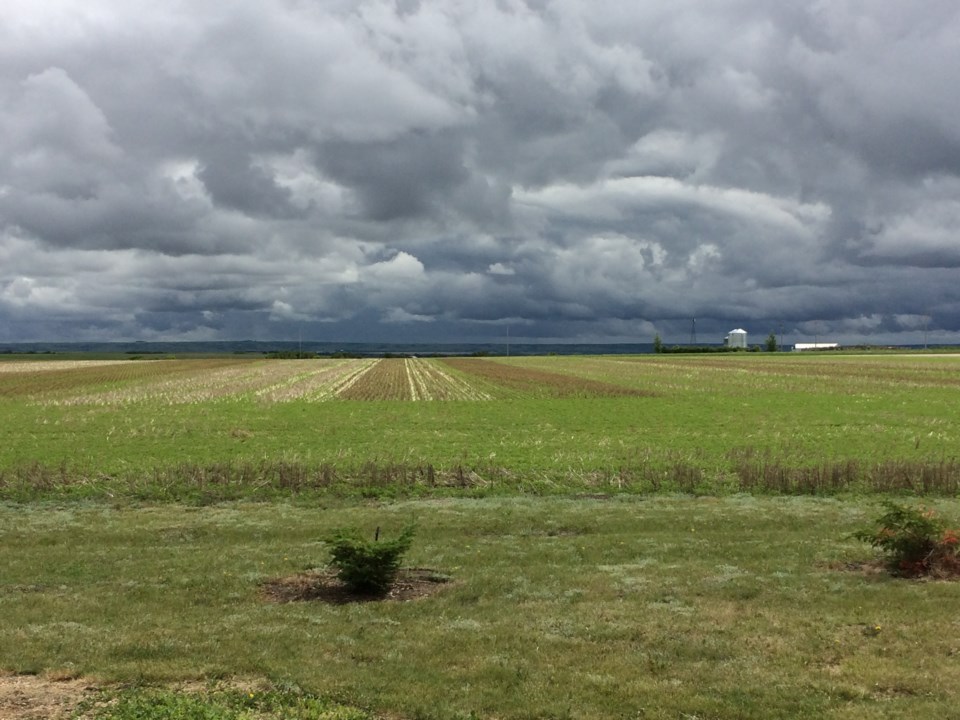Saskatchewan is always the land of the living skies, but that moniker rings even more true during big thunderstorms like the one that swept through Saskatchewan this past weekend.
After the powerful storm cell moved through the entire province, weather experts are reminding residents that being prepared for severe weather is always a good idea — and that storms can be very dangerous.
Assiniboia and Glenbain saw tornadoes touch down and wreak havoc, while large portions of Saskatchewan also experienced hail, lightning and plough winds that caused serious damage.
Winds even reached over 140 kilometres per hour, according to Terri Lang, a meteorologist with Environment and Climate Change Canada, and some regions saw hail as large as baseballs.
Storm enthusiasts lit up the #SKStorm hashtag on Twitter over the weekend, sharing photos of lightning, funnel clouds, and damage caused by wind and hail.
And according to Lang, the province can expect more severe weather on the horizon, as storm season is just getting started.
“We are in the heart of severe weather season,” said Lang. “This is the time of year when we do get the most storms, [and] people shouldn’t be surprised when there is severe weather.”
Storm season stretches from the end of May all the way to the middle of August. June and July usually see the most activity, said Lang, as crops dry out and release moisture into the air that helps stir up the tension.
But wild weather is hardly a surprise to most Saskatchewanians, as the province tends to be a hotbed for severe weather activity in the summer and many folks even enjoy stepping outside to witness the wild skies as storms roll in.
“I think Saskatchewanians, we love thunderstorms and most people love watching them because they’re quite fascinating,” said Lang. “But it is important to do that safely.”
The first step to being prepared for severe weather is to be aware, said Lang.
Saskatchewan weather can be unpredictable, with patterns constantly changing and shifting, and so Lang recommends staying up to date on your local forecast — including storm watches and warnings.
For many, the most convenient way to stay up to date is likely on their cell phone, where weather apps can push weather warnings right into your palm as they occur.
Lang recommended downloading WeatherCan, Environment Canada’s mobile app that provides up-to-date weather alerts based on your phone’s location, as well as SaskAlert. Both mobile apps issue severe weather warnings as they evolve and are an easy way to know if you may be in the storm zone.
She also explained that hearing about a thunderstorm watch is the signal to be alert, while a thunderstorm warning means it's time to get inside and take some cover.
“If you’re forecast is saying, ‘risk of severe storm,’ that should make your ears perk up a bit,” said Lang. “Then when we issue a warning, be it a thunderstorm or a tornado warning, it’s time to take action.”
The next step to severe weather preparedness is actually Environment Canada’s mantra: “when thunder roars, go indoors.”
While most people know to find cover when a tornado is imminent, Lang reminded residents that lightning, hail and plough winds can be just as dangerous.
While Saskatchewan is located in what many call Tornado Alley, plough winds have actually become more common. The best thing to do, if a plough wind seems to be brewing, is to put away any outdoor items that could potentially blow away and cause damage, and take cover indoors.
“Plough winds can produce just as much damage as tornadoes [and] lightning kills and injures more Canadians than any other type of severe weather,” said Lang.
Lightning can travel as far as 10 to 20 kilometres away from the heart of the storm and often occurs before the rain even begins.
“If you can see lightning and hear thunder, that’s when it's time to seek shelter because when you can see it, it can find you,” said Lang.
When taking cover for any kind of severe weather incident, Lang recommends finding a place in your home or the nearest building away from any windows, in the interior of the building — such as basements, crawl spaces, or bathrooms. Seeking shelter in a vehicle works as well, provided that it is enclosed.
“You want to put as many walls as you can in between yourself and outside, especially if you don’t have a basement or interior room without windows,” said Lang.
It’s important to take action sooner rather than later, continued Lang, as the majority of deaths or injuries in storms actually occur either before the rainstorm or shortly after. Lang recommends taking cover inside as soon as a storm approaches and waiting at least 30 minutes after a storm finishes before heading back outside.
Overall, the most important piece of advice is to have a plan and stay aware of brewing storm activity.
“It's sort of a luck of the draw, where the severe weather hits and where all the things come together, [so storms] can be very localized,” said Lang. “But this is going to go on for at least another month, so people should be prepared, whether they’re camping out on the lake, at the cottage or at home.”
Tornado on the ground south of Glenbain, Saskatchewan 4:30pm #SKstorm pic.twitter.com/pZAYzXLNIi
— Craig Hilts (@CraigHilts71) July 4, 2020
Saw one of the best shelf clouds I've ever seen last night. 🌩️ Taken around Avonlea, SK. #SKstorm #StormHour pic.twitter.com/A6jGmLBB7Q
— HERRY (@herry_with_an_e) July 8, 2020
Lightning back lit storm and a fading sun yes please #skstorm #saskatchewan #ShareYourWeather pic.twitter.com/UHedS95xEl
— Craig Boehm (@Skstormchaser) July 4, 2020




